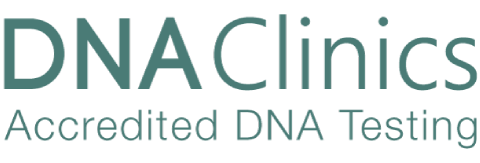Paternity DNA Testing
Paternity DNA testing is the most popular test we perform. The test includes samples from the child, the mother and potential father. It is possible to perform ‘motherless’ paternity testing, but we always recommend that the mother does take part to increase accuracy. Also, the paternity test is the most appropriate to use if you want to change a birth certificate.

How does Paternity testing work?
We analyse many genetic locations in a paternity test. A person possesses two (of many possible) alleles at each genetic location. We identify the alleles by numbers and produce a list of two columns of numbers for each person. These ‘numbers’ come from the parents at conception. One comes from the mother and one from the father.
Next, we list the DNA profiles of biological parents together by location. From this, the child’s alleles will match up with the mother's, while the other should match up with an allele from the biological father.
If the alleles match at all locations, we will include the person as the biological father of the child. This proves they have passed these genetic markers to the child at conception.
Locations where there is NO match will exclude a person as a biological father. This is because it is only possible to pass on to your off-spring the alleles which you have in your own DNA profile.
Frequently Asked Questions
How long does it take to get your paternity DNA test results back?
The analysis time needed in the lab for the paternity DNA test is three to four working days*. We will always endeavour to get the results to you as quickly as possible.
*Quoted lead-times are based on from when samples are booked onto the laboratory system. Also, quoted lead-times do not apply when issues arise from documents or samples provided that do not meet our quality guidelines.
Does the mother need to take part in the paternity test?
Getting an accurate result for this test is of the utmost importance to us. We recommend that you include the biological mother of a child in your test as we can accurately determine which DNA markers have been inherited from the mother and which markers relate to the alleged father. Also, we will test the mother’s DNA for free as it improves the accuracy of the result. As mentioned, a motherless paternity test can be undertaken. But you must be aware of the decrease in the statistical percentage.
Also, if the father is not available for testing, you could consider sibling DNA testing or grandparent DNA testing. This is an indirect way of establishing paternity. Please call 0800 988 7107 and speak to a Clinical Advisor to discuss your options.
How do I order a paternity test?
Here are the options available to you:
- Order a Paternity Test kit from Boots*.
- Order a free Paternity Test from DNA Clinics*.
- Call 0800 988 7107 to make an appointment at a DNA Clinic or order a *DNA self-collection Home Kit.
- Call 0800 988 7107 to arrange a home visit from a sample collection officer.
- You or your solicitor can contact us to organise a legal paternity DNA test for court purposes.
* Please note, you can only use self-collection kits for peace of mind purposes only. This test cannot be used for legal purposes.
How do I collect my own paternity DNA samples?
We have provided some useful guidance for test participants collecting their own samples for a DNA paternity test.
How accurate is a paternity DNA test?
At least 99.9999% probability for inclusion (positive result) as a biological father. This result means that a person is at least 1 million times more likely to be the biological father of the child tested. This is against an unrelated individual from the same ethnic group. In this case, this relates to a test which includes the mother’s DNA sample.
For negative results, the probability is 0% when excluded as a biological father. This result means that there is 0% chance that the person tested is the biological father of the child.
This DNA test is the gold standard for paternity testing. It provides conclusive results and the highest levels of accuracy. But when the mother of the child is not tested, the DNA evidence available to the laboratory decreases. For a positive paternity test result, the probability of paternity must be very high. In most cases when we include the mother in the test, this probability of paternity is over 99.9999%.
When the mother is not tested, this percentage can decrease to 99.99%. But we will still report this as a positive paternity result. This is because this high percentage still proves paternity.
What if any potential fathers are related?
If this is the case, you must discuss this with our clinical team. For example, this includes if potential fathers are brothers, father or son etc. We may still be able to undertake this test for you. A Clinical Advisor will talk you through the options available.
How much does a paternity DNA test cost?
You can see examples of paternity DNA test prices using the link below.
Local DNA Clinics and mobile locations throughout the UK
For your convenience, we have a network of DNA Clinics throughout the UK. As a result, we can provide paternity test appointments for you in your local area. Alternatively, we can arrange for a certified sample collection officer to visit your home or other convenient location of your choice.
Head Office
Crystal Health Group
The Old Chapel
Manchester
M30 0NG





